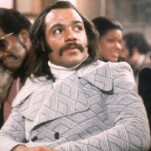September 24, 2010
If Love And Rockets: New Stories #3 (Fantagraphics) only contained Gilbert Hernandez’s 36-page “Scarlet By Starlight,” it would still be one of the most significant new comics of the year. Set on a distant planet where a small band of Earth scientists exploit the monkey-like natives, “Scarlet” is a shocking, haunting story about how guilt clings to people like tiny hairs. It also serves as an illustration of how small ethical lapses open the door to much larger ones. Gilbert’s second story in New Stories #3, “Killer * Sad Girl * Star,” is much stranger, changing the details of the “Scarlet By Starlight” into an old movie that a curvy, jailbait B-picture starlet is being asked to remake. The teen bombshell then embarks on her own surreal, seamy adventure that blurs the line between fiction and fact, and brings in some of Gilbert’s older L&R cast members. But as good as those two pieces are, they aren’t the book’s highlight; that honor goes to Jaime Hernandez’s intertwined stories “The Love Bunglers” and “Browntown.” (The latter appears between the two parts of the former, serving as an extended flashback.) “The Love Bunglers” catches longtime fans up on the love life of Maggie Chascarillo as she attends an art opening with her ex-boyfriend Ray Dominguez. Both characters take turns narrating, explaining their expectations and experience of the night, complete with recollections of dreams and shared histories. Meanwhile, on the edges of the story, a stranger lurks. “Browntown” explains who that stranger is via scenes from Maggie’s childhood, during the time when her family was still together and living in a small town far from her beloved barrio of Hoppers. The story takes place over a couple of years as Maggie turns 13, learns some unpleasant secrets about her folks, and takes her cues from her rapidly maturing best friend Letty, to whom she writes spleen-venting letters. And while she’s enduring routine adolescent angst, her younger brother is learning the meaning of sacrifice from some older boys. “The Love Bunglers” and “Browntown” offer the kind of rich, intricate stories—packed with sharp observations about human desire and self-justification—that only an author with 30 years of experience with these characters could write. But readers don’t need to have read all the previous Maggie tales to follow them. Everything a newcomer needs to know is woven neatly into the stories themselves, and although the nuances of the Maggie-Ray relationship will mean more to people who know the characters well, there’s a clear mastery to the way Jaime plays the couple’s fading bruises in “The Love Bunglers” against the sharp stings of “Browntown.” There are acclaimed filmmakers and novelists who can’t do what Jaime Hernandez does—or Gilbert, for that matter. When the two of them are at their most inspired, as they are here, they make almost every other comics creator today look like a fumbling hack… A
Living in a candy store may sound like every kid’s fantasy, but as Martin Lemelman’s memoir Two Cents Plain: My Brooklyn Boyhood (Bloomsbury) attests, the reality is more than a little bittersweet. With a mother haunted by the Holocaust and shtetl superstitions and a father pining for the bad old days in Stalin’s army, Lemelman’s formative years in Brownsville, Brooklyn were a pungent mixture of old country and new. As with his “memoir” Mendel’s Daughter, which he wrote from his mother’s perspective, much of Two Cents Plain is described in the fractured English of Lemelman’s immigrant parents, with all its shifty syntax and transposed froms and ofs intact. That voice—along with Lemelman’s smudgy pencil sketches, family photos, and scanned childhood artifacts—brings these often-understated vignettes to life, even when they’re recounting something as mundane as attrition warfare with insects. The ever-present roaches aren’t the only thing Two Cents Plain shares with Will Eisner’s tenement stories, and the book doesn’t shy away from the cycles of racial strife and neighborhood death and renewal that characterized Brooklyn following World War II. Like a two-cent seltzer water, this graphic memoir is an unassuming treat, whether sipped a story at a time, or quaffed in one satisfying sitting… A-
When Joe Quesada pulled his infamous “don’t-call-it-a-retcon” in the justifiably reviled “One More Day” storyline in 2007, Peter Parker’s marriage to Mary Jane Watson was retroactively undone in a deal with Mephisto. (That undoing being Mephisto’s bizarre fee for erasing the knowledge of Spider-Man’s no-longer-secret identity from the minds and records of the human race.) With Quesada’s recent storyline, “One Moment In Time,” the Marvel chief tries to polish his turd a little bit—but by the final issue of the arc, The Amazing Spider-Man #641, all he’s made is another mess. The double-sized issue concludes the retcon-of-a-retcon, in which Quesada attempts to retell “One More Day” by filling in gaps and adding another layer of hand-wringing anguish to the turbulent romance of Peter and Mary Jane. There are flashes of poignancy—such as Dr. Strange telling Reed Richards and Tony Stark that Peter Parker, while not the most powerful superhero, is “truly the best of us”—and the rotation of different artists throughout the book (including the restrained, fine-lined, but sadly paint-free Paulo Rivera, and of course, Quesada himself) actually works, giving the story the fragmentary feel that fits such a reality-altering brouhaha. But with the words “ramifications” and “consequences” bandied about by the brow-winkled characters every other panel, it’s hard to read “One Moment In Time” as anything other than Quesada’s belated—and wholly insufficient—apology to Spider-Man fans for “One More Day.” Due to a “scheduling snafu”—or perhaps an underhanded attempt to blunt the anticipated backlash from “One Moment In Time”—The Amazing Spider-Man #642 was released the same day as #641. The difference is night and day: First of all, Mark Waid wrote it, and this first installment of his new “Origin Of The Species” arc parallels the “Brand New Day” storyline that immediately followed “One More Day”—at least in the sense that it seeks to present a solid, punchy Spider-Man adventure after the gravitas and continuity-tangled nonsense of the preceding slog. Bringing together dangling threads from a few previous Spider-Man storylines (including Waid’s own “The Gauntlet” from a few months back), the debut of “Origin” is a warmly scripted, swiftly paced onslaught of classic Spider-Man villains and equally classic Peter Parker sad-sack-isms. Waid reunites with his “Gauntlet” and Potter’s Field teammate Paul Azaceta, whose chalky, blocky, brilliant art captures a new kind of Peter—and signals a breath of fresh air… #641: C-; #642: B+
EC Comics had the best artists and the most charismatic owner, but EC’s horror titles were relatively classy in comparison to what some of the smaller publishers were pumping out in the pre-Comics Code Authority era. The Greg Sadowski-edited anthology Four Color Fear: Forgotten Horror Comics Of The 1950s (Fantagraphics) collects stories from books with titles like Weird Thrillers,Chamber Of Chills, Beware, Mister Mystery, and Blue Bolt Weird Tales Of Terror, featuring art by the likes of Jack Cole, Basil Wolverton, Al Williamson, Wally Wood, Joe Kubert, and Frank Frazetta (some of whom were also EC regulars at the time). The colors are garish, the stories grotesque, and the art much freakier than the norm. Where EC’s comics are more akin to the drive-in fodder of American International Pictures, the comics in Four Color Fear are the equivalent of a David F. Friedman grindhouse roughie: lurid, exploitative, and just plain wrong. In short, this book is awesome. Making it even more awesome is Sadowski’s annotation: Four Color Fear ends with brief but informative commentary on each story, complete with comparisons to the other pulp titles that were around in the early ’50s. A lot of the actual comics in this book are more noteworthy for their gaminess than their quality, but the layer of scholarship is enough to make reading about decaying zombies and devil-worshippers seem almost ennobling… A-



































![Rob Reiner's son booked for murder amid homicide investigation [Updated]](https://img.pastemagazine.com/wp-content/avuploads/2025/12/15131025/MixCollage-15-Dec-2025-01-10-PM-9121.jpg)



